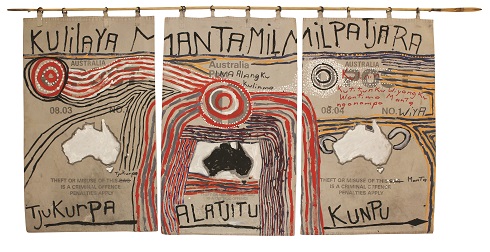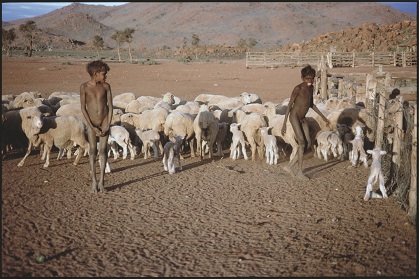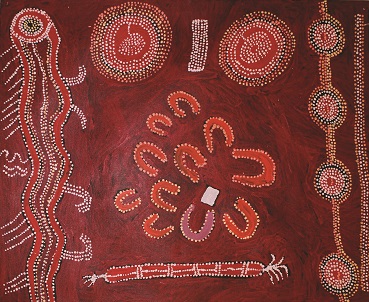Kulinmaya! - Keep Listening!

'Listen Up! Our Land is Sacred' - three panel 'Postbag Painting' (2016) by Mumu Mike Williams, hanging from Sammy Dodds's dead straight Kulata
Jeremy Eccles | 16.04.20
Author: Jeremy Eccles
News source: Review
Is there anything new under the sun??? I imagine that the late Mumu Muke Williams would have been well aware that there wasn't. And I'm beginning to think likewise having discovered that Williams's very special book – 'Kulinmaya! - 'Keep Listening Everybody' – was actually presaged by that extraordinarily prescient public servant, Nugget Coombs in 1978 when he titled a book, 'Kulinma, Listening to Aboriginal Australians'.
How little of that we've done in the intervening 42 years. If we'd even read the book, we'd have been able to take on board his proposal for something called a Makarrata, the 'coming together after a struggle' that's been proposed once again in the recent Uluru Statement from the Heart.
I was also lead by Kunmanara Williams's political history to go back to the writings of the late Peter Brokensha, who lived with the Pitjanjatjarra at Amata in the APY Lands in the late 70s and played a small part in the tribe's Land Rights movement. It had been first suggested by Don Dunston in 1966 but was eventually delivered when he'd lost power in SA by David Tonkin in 1981. Williams both hailed that and painted the scene at the hand-over ceremony, but, more recently, has come to realise that the white man's Land Rights was all about “the dust” not the unfettered control of the land needed by his people.
And finally, I was able to turn to Judith Crispin's charmingly poetic 'The Lumen Seed', which, though mainly about her engagement with the Warlpiri of Lajamanu, includes a timeline of Britain's heedless atomic testing at Emu Field and Maralinga. Mumu Mike Williams was just 4 when he experienced the shock of the first nuclear explosion at Maralinga in 1956 – assuming it was the Rainbow Serpent causing the earth to shake until he encountered the bodies of his people being “carted around in a wheelbarrow by the whitefellar missionary and buried in the bush” at Ernabella.
His brother-in-law, Yami Lester, of course, experienced the tests more directly, losing his sight. And Williams's 'Irati' paintings have a black cloud of 'Poison' hanging over the heart of a country where, “In the time of our ancestors, everything was good on the land”. And I suspect a lot of that goodness survived into Mumu Mike's stockman days when he was able to listen to the elders, be initiated and take part in ceremony.
Strangely, though, it was not these experiences that politicised Williams. That was the destruction of the rocks that marked his birthplace to build a road. “Government, anthropologists and the land council were all deaf”, he spreads the blame.
From then on, Mumu Mike began his iconic series of postbag paintings – sending a reverse message back on the government mailbags to the unthinking authority that despatched them to the deserts. “Theft or Misuse of this Bag is a Criminal Offence. Penalties Apply” is boldly stencilled on each. Williams both ignores the threat and changes the word 'Bag' on each to 'Manta Munu'. They now read, “Theft or Misuse of this Land and Cultural Heritage is a Criminal Offence”.
For, “The government is not part of our Law and culture”, he asserts. So adding a map of Australia to each bag or borrowing a printed map marked with the names of places and borders or boundaries and overwriting them in Pitjanjatjarra is his way of showing, “They're not our boundaries. Anangu are the true owners of this land”. And that might just mean the whole of Australia, not limited to the APY Lands.
It's remarkable how often people – including urban Aboriginal artists – assert that they are the only political artists fighting for the Indigenous cause, while their remote brothers and sisters are merely being decorative! Many a commentator, too, thinks that this 'classic' art makes no demands on non-Indigenous viewers. The other furphy that this book disproves is that tribal people operate only as a group, a community. Kunmanara Williams is very much his own man in creating this book, a long-held ambition, though clearly he's not alone in the APY communities - including the women, who get comparatively short shrift in this book - in holding strong views about Land Rights and Anangu's relationship with governments, miners, etc.
For instance, Williams has a constant partner-in-art in the nuggety Sammy Dodd, a man of Afghan and Pitjanjatjarra ancestry and the gun spear-maker in the Lands. His skill in converting the bendy spearbush into dead straight kulata is legendary. And Mumu Mike responds by invariably hanging his postbags from a spear or commissioning a hundred or so to be employed in an ever-expanding series of installations, from the kulata fence that appeared at the first Tarnanthi Festival in Adelaide – as suggested by Yami Lester to represent a metaphorical defence for their waterholes and sacred sites – to the intricate spillikins installation at a later Tarnanthi event, now heading for France this year. As Williams suggests in the book, “maybe (non-Aboriginal) viewers can come to understand what they might be losing from their cultures too”.
In this 250th anniversary year of Lieutenant Cook's non-circumnavigation of Australia, it's salutary to get Mumu Mike Williams's take on the man. “His arrival was like a huge whirlwind, announcing an empty land and causing untold damage”. The artist/author goes on to blame him for allowing the government to think it “owns the land inside”, where minerals and (just as importantly) flat grindstones can be found. Several mentions in the book of the Ngintaka Tjukurpa which features the ultimately futile efforts of the Perentie Man to steal the perfect grindstone for his wife to mill Dreamtime seedcakes emphasise this essentiality.
Which brings Williams to his timeless conclusion. For the loss and recovery of Land Rights (however deficient) was surely predicted in the Watarru Tjukurpa in which the Brush Turkey stole the fire and took it into the sea. But, pursuing and spearing the Turkey, two Zebra Finch Men returned the fire and “threw it across the land. Without fire we were cold and miserable. Without our Tjukurpa we are weak and powerless. So, those of us that were there to receive our land back (at Itjinpiri, where a Ngintaka ceremony was held) keep holding on to it as strongly as we can. This is a good thing”.
Congratulations, therefore to Mumu Mike Williams – who approved the text just before he died last year – for allowing us to appreciate a voice so viscerally from the Deserts, translated so sensitively by Linda Rive. And praise too for Allen & Unwin, for whom publishing this book so splendidly might not have seemed such a profitable idea. RRP is $35.
URL: https://www.allenandunwin.com
Share this:
»  del.icio.us
»
del.icio.us
»  Digg it
»
Digg it
»  reddit
»
reddit
»  Google
»
Google
»  StumbleUpon
»
StumbleUpon
»  Technorati
»
Technorati
»  Facebook
Facebook
Contact Details

Picture from an innocent time - Mumu Mike (R) and his cousin/brother Tjilari Edwards bringing in the sheep at Ernabella in 1963

An early, 2012 work by Kunmanara Wiliams, 'Land Rights Act', with SA Premier Tonkin in pink delivering the Act at the Itjinpiri ceremony
Further Research
Artists: | Mumu Mike Williams | Sammy Dodds
News Tags: David Tonkin | Jeremy Eccles | Linda Rive | Maralinga | Mimili Maku Art Centre | Nugget Coombes | Peter Brokensha | Yami Lester
News Archive
- 20.04.20 | CIAF 2020
- 16.04.20 | Kulinmaya! - Keep Listening!
- 15.04.20 | Nothing Revealed
- 10.04.20 | Marginally Good News
- 06.04.20 | ON & OFF IN ABORIGINAL ART
- 03.04.20 | the dickens boy
- 27.03.20 | Arts Activism
- 26.03.20 | Out on Country!
- 22.03.20 | Another Coronavirus Crisis
- 19.03.20 | BIENNALE OF SYDNEY 2020
- 13.03.20 | LAURIE NILSEN
- 06.03.20 | Indigenous Arts Infrastructure
- 03.03.20 | EMILY v CLIFFORD
- 02.03.20 | The Ephemeral and the Ineradicable
- 25.02.20 | WADJUK IN THE BLACK
Advertising

